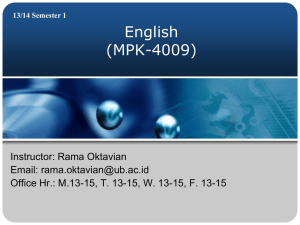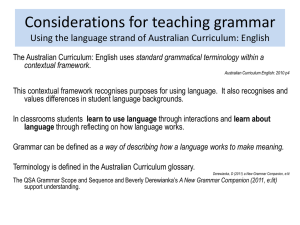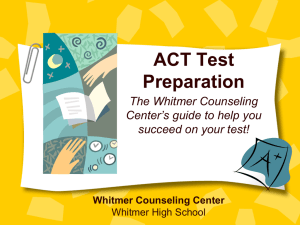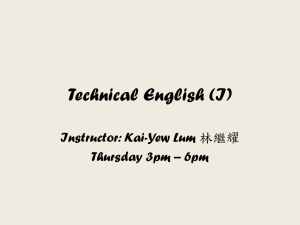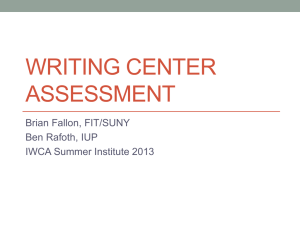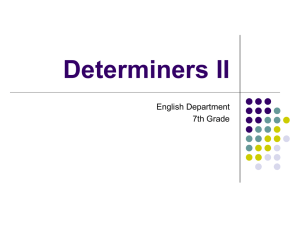Evaluate Your Program
advertisement
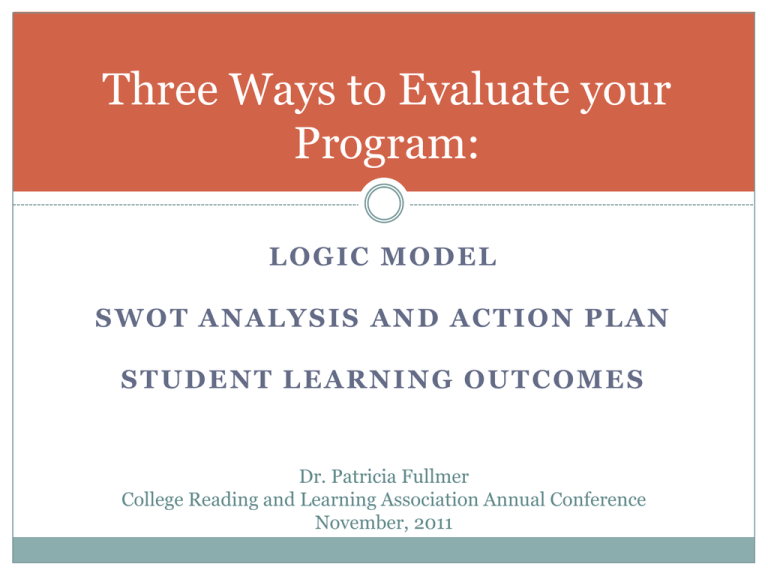
Three Ways to Evaluate your Program: LOGIC MODEL SWOT ANALYSIS AND ACTION PLAN STUDENT LEARNING OUTCOMES Dr. Patricia Fullmer College Reading and Learning Association Annual Conference November, 2011 Agenda Overview of Evaluation Logic Model SWOT Analysis and Action Plan Student Learning Outcomes Learning Outcomes Gain an overview of evaluation. Create a logic model. Generate a SWOT analysis and action plan. Craft student learning outcomes. Overview of Evaluation: Types Summative: Document the results of the program. Formative: Improve the program. Why Evaluate? Required by Funding Sources: Government Grants University/College funds Required by Accrediting Organizations: Middle States, Southern States, etc. Council for the Advancement of Standards in Higher Education (CAS) Self-Improvement: Determine how and where to improve your program’s services. Document Effectiveness: Demonstrate your program is valuable and worthwhile! How do you conduct Evaluation? Evaluation Process: 1. Who does the evaluation? Evaluation committee/staff 2. Evaluation Design: Determine evaluation questions Determine what information to collect and when Determine the source, methods and instrumentation of data collection Examine information: Analysis and Interpretation Generate results 3. Use of evaluation results Characteristics of Good Evaluation Comprehensive Uses variety of methods Uses multiple sources Considers multiple perspectives Uses comparisons Systematic Continuous Methods and Instruments Direct Measures Indirect Measures Pretest/Posttest Self Reports: Projects Portfolios Professional subject area assessments Surveys Interviews Focus Groups Questionnaires Grades Collecting Data: Considerations Validity Reliability Quantitative Qualitative Rubrics Protocols Population Sampling Timing-When to collect data Use of the Results of Evaluation 1. 2. Demonstrate effectiveness Make decisions for ongoing improvement: Modify goals and processes Determine an improvement/action plan Allocate funds Apportion resources Logic Model THE INITIAL STEP IN THE EVALUATION PROCESS What is a Logic Model? Describes your program visually Picture of the program’s: “Theory of Change”: Events & activities that are expected to create a change, resolve a problem-describes the desired results Shows what leads to the desired results: Actions Results Inputs Outputs Outcomes Benefits of a Logic Model Builds mutual understanding Helps initiate an evaluation: Determine the wanted outcomes Decide what to measure and assess Establish at what point in time to conduct the evaluation and collect the data Summarizes the program Improves planning Identify gaps in services Guides use of resources and funds Qualities of a Logic Model Group Process Meaningful Reasonable Realistic/Attainable Measurable Components of a Logic Model Inputs Outputs Outcomes/Impact Assumptions External Factors Where to Start? AT THE END!!! THEN PROCEED BACKWARDS!!! 1. 2. 3. 4. What are the desired outcomes? Who will be the participants? What will be the services and activities? What are the resources needed? Learning Resource Center Logic Model Inputs Outputs Activities What we invest: Participation What we do: Who we reach: Funding: University funds Title III funds Act 101 funds Tutoring Labs Online tutoring programs Staff: Tutors Peer Tutors Secretary Administrators Review minilessons Training for staff-CRLA Certified Writing Portfolio assistance Online programs and access codes Mini-Lesson plans and exercises Workshops Individual tutoring Students Students’ Families Faculty Administrators Alumni Summer Bridge Peer Tutoring Collaboration with academic departments and administrators Outcomes -- Impact Short Medium This semester’s results: Next Results in 4-6 semester/next years and more: year’s results: Students Students Students increase successfully increase their their GPA graduate Lincoln skills to with skills for college level Students persist graduate school or and return the the fast track in a Students earn next corporation a B or above semester/next in their year Lincoln’s course graduation rate Students become increases Students successful increase life academically, Lincoln’s skills and socially, and reputation coping skills emotionally at increases Lincoln Students More and better adjust to Lincoln’s prepared students college life retention rate are attracted to increases Lincoln Act 101 Program Assumptions: Following best practices in our services will help students increase their skills. Increased student skills will improve retention and graduation rates. Increased graduation rates will help attract students and increase Lincoln’s reputation. Perception of LRC by Faculty, Administrations, and Students Long Growth of Lincoln External Factors: Location Economy State and federal funding University of Wisconsin-Extension (2003). Enhancing program performance with logic models. Retrieved from lmcourse@ces.uwex.edu Writing Lab Logic Model Inputs Outputs Activities Participation What we invest: What we do: Who we reach: Professional Writing Tutors Tutoring Labs Students Mini review grammar lessons and exercises Writing Labs that address grammar Students’ Families Faculty Required tutoring laboratories Drop-in tutoring Administrators My Writing Lab software Appointment tutoring Individual assistance for all students in writing Writing Portfolio Assistance Conducive lab environment Student development workshops Computer and Internet Access Alumni Assumptions: Following best practices in our services will help students increase their skills. Increased student skills will improve retention and graduation rates. Increased graduation rates will help attract students and increase Lincoln’s reputation. Perception of LRC by Faculty, Administrations, and Students Outcomes -- Impact Short This semester’s results: Medium Long Next Results in 4semester/next 6 years and year’s results: more: Students gain an Ability to construct understanding of a thesis driven the structure of essay an essay Students utilize the Ability to LRC on a regular construct a topic basis sentence and thesis statement Expansion of with areas of students’ support vocabulary Students are able to write proficiently across the curriculum Satisfaction of writing portfolio requirements Ability of students able to General Ability to conduct write a knowledge of research properly comprehensive proper grammar and coherent and punctuation Understanding of response to proper work graduate level Faculty citation exams collaboration External Factors: Location Economy State and federal funding University of Wisconsin-Extension (2003). Enhancing program performance with logic models. Retrieved from lmcourse@ces.uwex.edu SWOT Analysis and Action Plan AN INTERNAL AND EXTERNAL PERSPECTIVE OF YOUR PROGRAM SWOT Analysis and Action Plan SWOT Analysis Action Plan Strengths Build on strengths Weaknesses Opportunities Threats Take advantage of opportunities Address weaknesses Address threats Writing Lab SWOT Analysis Strengths: What is done well? Evaluation of success indicators has resulted in collaboration on content goals and agreement to move to a mastery system addressing core skills of college English grammar. Weaknesses: What could be improved? Factors for poor student attendance include the following potential causes: 1. Since students are not given credit for labs. Tutors developed several writing workshops that were presented in a broad range of academic disciplines. 2. The LRC continues to have a credibility issue. Tutors make classroom visits at beginning of semester. 3. Students do not receive a letter grade for the lab. Tutors continue to offer extended hours for make-up labs and dropins for students seeking professional tutoring. 4. There is no uniformity among professors teaching the course about how best to incorporate lab work in the overall grade for the course. The Writing Lab has a professional staff that is dedicated to nurturing student success. Students with low proficiency in reading and writing are often hesitant to participate in lab sessions. All of the tutors have earned CRLA Level I & II certification and continue training on a regular basis each semester. One weekly 50-minute lab session is insufficient time. Opportunities: What are the opportunities open? Threats: What are the obstacles? Design student development workshops and increase in-class presentations of workshops in order to improve students’ skills and knowledge of the writing process and expand the visibility of the LRC. Creation of a mastery system addressing core skills of college grammar, to improve students’ proficiency in reading and writing. Lack of competitive salaries or salary raises contributes to low tutor retention and high tutor turnover. Some of the university’s faculty population holds a poor perception of the LRC which results in lack of support from individual faculty or entire departments. Success students project a negative attitude towards the Writing Lab which diminishes students’ motivation and results in a decline in attendance during the semester. Writing Lab Action Plan Improvement Evidence The Writing Lab will focus on grammar mastery. The student will be required to master 20 identified areas of the 26 total areas of the Study Plan in My Writing Lab at 85% to be eligible to test out of the lab. Campbell, M. (1983). "Mastery Learning in the College Learning Center." Paper presented at the National Association for Remedial/Developmental Studies Conference, Little Rock, AK, March 1983, 19 pp. (ED 247 592). To test out of lab, students in English 098 and English 099 will be The study found that students need to understand the task at hand, required to score 85% on the post-test at midterm time. Students will the process, and the assessment involved in order for there to be be allowed to take the post test twice. successful learning. Lab tutors will focus on sentence grammar areas in My Writing Lab work. Input from Lincoln University English Department Composition Committee. Tutors will review sentence grammar facts twice in the semester. In weeks 6 and 11, the tutors will review previously covered material. Adult Literacy and Basic Skills Unit (1991). A self-directed approach to English grammar. Kingsbourne House, 229231 High Holborn, London, England WC1V 7DA, United Kingdom. The Writing Lab will increase its hands-on activities to help facilitate the mastery topic of punctuation in order to improve students’ writing aptitude. Boylan, H. (2002). What works: Research-based best practices in developmental education. Boone, NC: Continuous Quality Improvement Network/National Center for Developmental Education. Students will write sentences in lab. Accommodate diversity through varied instructional methods. Use technology with moderation. Brophy, L. (1988). Educating teachers about managing classrooms and students. Teaching and Teacher Education, 4(1), 3. This study found that increased time on task improved students’ skills. Information from the student survey. Student Learning Outcomes AN EVALUATION OF THE IMPACT OF YOUR PROGRAM Benefits of Student Learning Outcomes Fulfills accreditation requirements Fulfills funding requirements Establishes goals Tells us what success will look like! SMART Outcomes Specific Measureable Attainable Results-oriented Timed Writing Lab Student Learning Outcomes Student Learning Outcomes Assessment Method Students will increase their skills in the area of sentence grammar. Results of pre and For students who post attended six or more diagnostic tests. sessions: English 098 students will show a 50% improvement from the pre test to the post test in sentence grammar for those who attend six or more sessions. English 099 students will show a 33% improvement from the pre test to the post test in sentence grammar for those who attend six or more sessions. Findings English 098 students show a 50% improvement in sentence grammar. English 099 students show a 47% improvement in sentence grammar. Modified Student Learning Outcomes Action Plan Students will increase their skills in the area of sentence grammar. Students will improve sentence grammar by: English 098 students will show a 53% improvement from the pre test to the post test in sentence grammar for those who attend six or more sessions. English 099 students will show a 50% improvement from the pre test to the post test in sentence grammar for those who attend six or more sessions. Focusing on mastering all sentence grammar areas in My Writing Lab. Write sentences in lab. Receive tutor assistance with the online program. Tutors giving students two review lessons during the semester to help reinforce grammar facts. References Adult Literacy and Basic Skills Unit (1991). A self-directed approach to English grammar. Kingsbourne House, 229-231 High Holborn, London, England WC1V 7DA, United Kingdom. Boyd, H. (2002, November 22). Use comparison groups to strengthen your evaluation. (Audio Conference). Retrieved from: http://www.uwex.edu/ces/pdande/resources/pdf/agenda.pdf Boylan, H. (2002). What works: Research-based best practices in developmental education. Boone, NC: Continuous Quality Improvement Network/National Center for Developmental Education. Brophy, L. (1988). Educating teachers about managing classrooms and students. Teaching and Teacher Education, 4(1), 3. Campbell, M. (1983). Mastery learning in the college learning center. Paper presented at the National Association for Remedial/Developmental Studies Conference, Little Rock, AK, March 1983, 19 pp. (ED 247 592). References (con’t) Council for the Advancement of Standards in Higher Education (2008). CAS Self-assessment guide for learning assistance programs. CAS: Washington, DC. Council for the Advancement of Standards in Higher Education (2008). History of CAS. from http: //www.cas.edu Dwyer, C. A., Millett, C. M., & Payne, d. G. (2006). A culture of evidence: Postsecondary assessment and learning outcomes. Princeton, NJ: Educational Testing Service. Kellogg, W. K. (2004). Evaluation handbook. . W. K. Kellogg Foundation: Battle Creek, Michigan. Kellogg, W. K. (2004). Logic model development guide. W. K. Kellogg Foundation: Battle Creek, Michigan. Nichols, J. O. (2008). The administrative unit assessment handbook: Guidelines for planning and implementing. Measuring student support services & administrative outcomes. Orlando, FL: University of Central Florida. Retrieved from: http://oeas.ucf.edu.doc/adm_assess_handbook.pdf Strategy: Create and implement the best strategy for your business, (2005). Boston, MA: Harvard Business School Press. References (con’t) SWOT analysis II: Looking inside for strengths and weaknesses, (2006). Boston, MA: Harvard Business School Press. Taylor-Powell, E. & Henert, E. (2008). Developing a logic model: Teaching and training guide. Madison, WI: University of Wisconsin-Extension, Cooperative Extension, Program Development and Evaluation. University of Wisconsin-Extension (2003). Enhancing program performance with logic models. Retrieved from lmcourse@ces.uwex.edu Wargo, M. C. (2007). Handbook for program assessment in administrative/educational support units. Western Carolina University Cullowhee, NC. Retrieved from: http://www.wcu.edu/WebFiles/PDFs/AssessmentHandbook_AES.pdf Weiss, C. H. (1972). Evaluation research: Methods for assessing program effectiveness. Prentice-Hall, Inc.: Englewood Cliffs, NJ.

